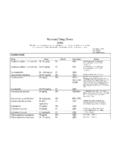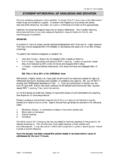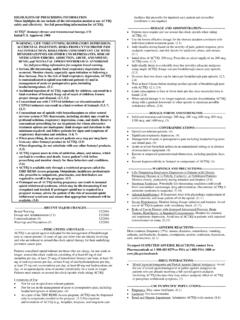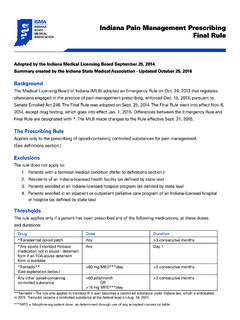Transcription of Geneva, 7 16 June 2016 - Home | Food and …
1 JECFA/82/SC - 1 - 82nd Joint FAO/WHO Expert Committee on Food Additives (JECFA) meeting Food additivesSummary and conclusions, 2016 geneva , 7 16 june 2016 Issued 21 june 2016 A meeting of the Joint FAO/WHO Expert Committee on Food Additives (JECFA) was held in geneva , Switzerland, from 7 to 16 june 2016 . The purpose of the meeting was to evaluate certain food additives (including flavouring agents). Dr A. Mattia, Center for Food Safety and Applied Nutrition, United States Food and Drug Administration, served as Chairperson, and Mrs I. Meyland, Denmark, served as Vice-Chairperson. Dr M. Lipp, Office for Food Safety, Food and Agriculture Organization of the United Nations, and Dr A. Tritscher, Department of Food Safety and Zoonoses, World Health Organization, served as Joint Secretaries. The present meeting was the eighty-second in a series of similar meetings. The tasks before the Committee were (a) to elaborate principles governing the evaluation of food additives (including flavouring agents); (b) to undertake safety evaluations of certain food additives (including flavouring agents); and (c) to review and prepare specifications for certain food additives (including flavouring agents).
2 The Committee evaluated the safety of 10 food additives, revised the specifications for 22 other food additives (including 16 modified starches), evaluated 26 flavouring agents according to the Procedure for the Safety Evaluation of Flavouring Agents and revised the specifications for six flavouring agents. The report of the meeting will be published in the WHO Technical Report Series. Its presentation will be similar to that of previous reports namely, general considerations, comments on specific substances and recommendations for future work. An annex will include detailed tables (similar to the tables in this report) summarizing the main conclusions of the Committee in terms of acceptable daily intakes and other toxicological, dietary exposure and safety recommendations. Information on the specifications for the identity and purity of certain food additives (including flavouring agents) examined by the Committee will also be included.
3 The participants in the meeting are listed in Annex 1. Items of a general nature that the Committee would like to disseminate quickly are included in Annex 2. Future work and recommendations are listed in Annex 3. Toxicological and dietary exposure monographs on most of the substances that were considered will be published in WHO Food Additives Series No. 73. New and revised specifications for the identity and purity of the compounds will be published in FAO JECFA Monographs 19. Summary report of the eighty-second meeting of JECFA JECFA/82/SC 2 More information on the work of JECFA is available at: and The issuance of this document does not constitute formal publication. The document may, however, be freely reviewed, abstracted, reproduced or translated, in whole or in part, but not for sale or use in conjunction with commercial purposes. Summary report of the eighty-second meeting of JECFA JECFA/82/SC 3 Toxicological information and information on specifications Food additives evaluated toxicologically and assessed for dietary exposure Food additive SpecificationsAcceptable daily intakes (ADIs) and other toxicological and dietary exposure conclusions Allura Red AC RaThe Committee concluded that the new data do not give reason to revise the ADI and confirmed the ADI of 0 7 mg/kg body weight (bw).
4 The Committee noted that the range of estimated dietary exposures to Allura Red AC for children based on reported or industry use data were below the upper bound of the ADI and concluded that dietary exposure to Allura Red AC for children and all other age groups does not present a health concern. Carob bean gum Rb The Committee concluded that the available studies are not sufficient for the evaluation of carob bean gum for use in infant formula at the proposed use The Committee requests toxicological data fromstudies in neonatal animals, adequate to evaluate the safety for use in infant formula, to complete the evaluation. Lutein esters from Tagetes erecta Rd The Committee removed the temporary designatione(because the tentative status of the specifications was removed) and established an ADI not specified for lutein esters from Tagetes erecta. Octenyl succinic acid (OSA) modified gum arabic RfThe Committee removed the temporary designationeand established an ADI not specified for OSA-modified gum arabic.
5 The Committee confirmed the validity of the dietary exposure estimate for risk assessment purposes set at a previous meeting. Pectin Rg The no-observed-adverse-effect level (NOAEL) in a previously evaluated neonatal pig study was recalculated to be 1049 mg/kg bw per day using measured concentrations of pectin in milk replacer rather than target concentrations. At the new maximum proposed use level of , the estimated exposure of infants 0 12 weeks of age would be up to 360 and 440 mg/kg bw per day at mean and high consumption. The margins of exposure for average and high consumers are and , respectively, when compared with the NOAEL of 1049 mg/kg bw per day. On the basis of a number of considerations, the Committee concluded that the margins of exposure calculated for the use of pectin at in infant formula indicate low risk for the health of infants and are not of concern. Quinoline Yellow Rh The Committee concluded that it was reasonable to use toxicology data on D&C Yellow No.
6 10 to support the database for Quinoline Yellow. The Committee established an ADI of 0 3 mg/kg bw (rounded value) for Quinoline Yellow on the basis of a NOAEL of 250 mg/kg bw per day for effects on body weight and organ weights Summary report of the eighty-second meeting of JECFA JECFA/82/SC 4 Food additive SpecificationsAcceptable daily intakes (ADIs) and other toxicological and dietary exposure conclusions in two long-term studies in rats on D&C Yellow No. 10. An uncertainty factor of 100 was applied to account for interspecies and intraspecies variability. The Committee concluded that dietary exposure to Quinoline Yellow for children and all other age groups does not present a health concern. Rosemary extract TiThe Committee established a temporary ADI of 0 mg/kg bw for rosemary extract, expressed as carnosic acid and carnosol, on the basis of a NOAEL of 64 mg carnosic acid + carnosol/kg bw per day, the highest dose tested in a short-term toxicity study in rats, with application of a 200-fold uncertainty factor.
7 This uncertainty factor incorporates a factor of 2 to account for the temporary designation of the ADI. The Committee made the ADI temporary pending the submission of studies to elucidate the potential developmental and reproductive toxicity of the rosemary extract under consideration. An additional uncertainty factor to account for the lack of a chronic toxicity study was not considered necessary based on the absence of adverse effects in the short-term toxicity studies at doses up to and including the highest dose tested. The temporary ADI applies to rosemary extract that meets the specifications prepared at the present meeting. It will be withdrawn if the required data are not provided by the end of 2018. The Committee noted that the dietary exposure estimates for rosemary extract for high consumers, mg/kg bw per day (as carnosic acid plus carnosol), may exceed the upper bound of the temporary ADI by up to (for young children at the top end of the range of estimated dietary exposures).
8 Based on the conservative nature of the dietary exposure assessments, in which it was assumed that all foods contained rosemary extracts at the maximum use level, the Committee concluded that this exceedance of the temporary ADI does not necessarily represent a safety concern. Steviol glycosides NjN,Tk The Committee confirmed the ADI of 0 4 mg/kg bw, expressed as steviol. The Committee also confirmed that rebaudioside A from multiple gene donors expressed in Yarrowia lipolytica is included in the ADI. The Committee concluded that it was not necessary to make the ADI temporary because the requested information to complete the specifications refers only to an update of the method and has no safety implication. The Committee noted that the predicted maximum dietary exposure to steviol glycosides of mg/kg bw per day for young children who were high consumers exceeded the upper bound of the ADI (up to 110%), but the ADI was not exceeded for other age groups.
9 Considering the conservative nature of the dietary exposure estimate, based on maximum use levels applied to all food consumed from categories with permissions for use in the countries assessed, steviol glycosides are not Summary report of the eighty-second meeting of JECFA JECFA/82/SC 5 Food additive Specifications Acceptable daily intakes (ADIs) and other toxicological and dietary exposure conclusions likely to present a health concern for any age group. Tartrazine Rl The Committee established an ADI of 0 10 mg/kg bw, on the basis of a NOAEL of 984 mg/kg bw per day for reductions in body weight in a chronic rat study, with application of a 100-fold uncertainty factor to account for interspecies and intraspecies variability. The Committee withdrew the previous ADI of 0 mg/kg bw per day. The Committee noted that the dietary exposure estimate for children aged 1 10 years was below the upper bound of the ADI and concluded that dietary exposure to tartrazine for the general population, including children, does not present a health concern.
10 Xanthan gum Rm A NOAEL of 750 mg/kg bw per day was established for xanthan gum in neonatal pigs, which are an appropriate animal model for the assessment of the safety of the additive for infants. The margin of exposure based on this NOAEL and the conservative estimate of xanthan gum intake of 220 mg/kg bw per day by infants (high energy requirements for fully formula-fed infants) is On the basis of a number of considerations, the Committee concluded that the consumption of xanthan gum in infant formula or formula for special medical purposes intended for infants is of no safety concern at the maximum proposed use level of 1000 mg/L. N: new specifications; R: existing specifications revised; T: tentative specifications a The method for the determination of lead was changed from atomic absorption to any method appropriate to the specified level. Updated HPLC conditions were added for determining subsidiary colouring matters and organic compounds other than colouring matters.















